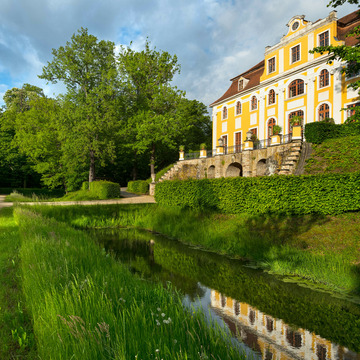The castle and historical park of Count Brühl
Ulrich von Promnitz commissioned construction of the building known as the "new castle" in 1670 and had a pleasure garden in a Renaissance style laid out beside it. Johann Jakob Mencke from Pförten was his garden architect. Mencke was court gardener to the Saxon electors and was dispatched to Warsaw in 1713 to lay out the Saxon Garden for Augustus II the Strong.
The castle park owes its heyday to Heinrich Graf von Brühl, however, who acquired Pförten in 1740 for 160,000 thalers. He initiated reconstruction of the residence, the associated district and the park in the Saxon rococo style. Johann Christoph Knöffel was the garden architect and the construction work was supervised by Carl Heinrich von Heinecken.
The main and transverse axes formed the garden's basic structures, with a symmetrical parterre de broderie at the centre. A promenade was moreover laid out around the lake. At the time, Pförten was often referred to as the "Pearl of Lower Lusatia" or the "Garden of Lusatia".
The baroque garden was landscaped following Brühl's death and the parterre replaced with a sweeping meadow featuring solitary trees and tree groves. The rare woody plants that can still be found here today such as the tulip tree, plane tree, hanging beech, black pine, yellow pine, bald cypress date from this period. Two islands were formed in the lake: Swan Island as an extension to the main castle axis and Love Island where there was a boat mooring. Both local residents and visitors were able to access the park.
After the Second World War, the park was no longer maintained and fell into disrepair. Native species stifled the valuable species of trees and woody plants planted here in the nineteenth and twentieth centuries. Since 2009, German-Polish park seminars have been organised in Brody during which volunteers from Germany and Poland perform clearance and maintenance work under professional supervision. Many old areas of the park and visual axes have already been opened up as part of this work. The part of the castle park belonging to the municipality of Brody is maintained continuously.
Brody castle park has been a member of the European Park Association of Lusatia since 16 November 2010. On the initiative of this association, six information boards were erected in 2012 along a circular
route that runs between the castle, town and park, and the historical sarcophagus in the park was restored in 2017 thanks to financial support from the Hermann Reemtsma Foundation in Hamburg.
Tourism offers
With the audio guide through the park.
Diese Karte kann nicht von Google Maps geladen werden, da Sie in den Datenschutz- und Cookie-Einstellungen externen Inhalten nicht zugestimmt haben.


































































